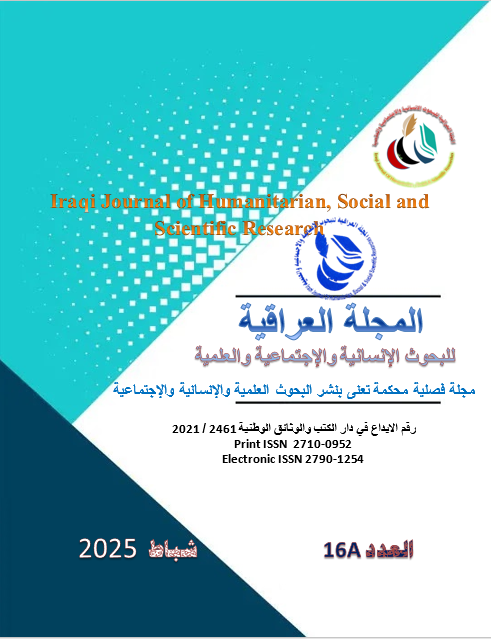Abstract
Huge praises are to god, by whose grace good deeds are accomplished and completed, and prayers and peace be upon our prophet “ Mohammed “ ( best blessing upon him ), and upon his family and companions… The current study shed light on one of the phenomena of the Arabic language, which is the phenomenon of great derivation, which refers to a remarkable mental ability and skill to employ vocabulary of the language and changing it. The idea of the theory is based on permutations, by taking the root of a word and turning it into six permutations, and these permutations lead to one meaning. “ Al-Kalilibn Ahmed “ was the first one who become aware of this phenomenon as that mentioned in his book ‘ Mu'jam Al-Ayn “, but he did not name it, and his goal was to count the language and remove the unused ones from it and “ Ibn Jinni “ is considered the first one who called this phenomenon as the great derivation, as he was fond of it, but he did not exaggerate it. He did not claim to be universal in all languages. The importance of this study lies in applying this theory to two subjects (kindness and child ) and knowing the common meanings between them inlinguistic use in light of the Arabic lexicon in respect to abstract and augmented verbs, refrences and derivatives, and then studying them in a general semantic study.The study concluded that this phenomenon can be applied to many language vocabulary, provided that it is not exaggerated, as well as other results mentioned in the conclusion with a list of sources and references
Keywords
Great Derivation
meaning and semantics
permutations
Abstract
الحمدُ لله الذي تتمُّ بنعمته الصالحات والصلاة والسلام على سيدنا محمد سيد الكائنات وعلى آله وأصحابه أفضل الصلوات أما بعد…فقد سلطت هذه الدراسة الضوء على ظاهرة من ظواهر اللغة العربية، ألا وهي ظاهرة الاشتقاق الكبير، والتي تنمُّ عن قدرة عقلية فذة، وبراعة في استعمال مفردات اللغة وتقليبها، أذ تقوم فكرة هذه النظرية على التقليبات بأن تأخذ جذر كلمة وتقلبها على ستة تقليبات، وهذه التقليبات تؤدي معنى واحداً. واول من فطن لهذه الظاهرة هو الخليل بن أحمد في كتابه معجم العين إلا أنَّه لم يسمها وكان هدفه منها إحصاء اللغة، وإخراج غير المستعمل منها. ويعدُّ ابن جني اول من أطلق على هذه الظاهرة اسم الاشتقاق الكبير، إذ ولع به إلا أنَّه لم يبالغ فيه، ولم يزعم إنه مطّرد في كلّ اللغة. وتكمن أهمية هذه الدراسة في تطبيق هذه النظرية على مادتين ألا وهما ( لطف وطفل ) ومعرفة المعاني المشتركة بينهما في الاستعمال اللغوي في ضوء المعجم العربي من حيث الأفعال المجردة والمزيدة، والمصادر والمشتقات، وبعد ذلك دراستها دراسة دلالية عامة. وقد خلصت الدراسة إلى أنَّ هذه الظاهرة يمكن تطبيقها على الكثير من مفردات اللغة، على أن لا يبالغ فيها، فضلاً عن نتائج أخرى ذكرت في الخاتمة مع قائمة المصادر والمراجع.
Keywords
الاشتقاق الكبير ، التقليبات، الصرف، الدلالة .
